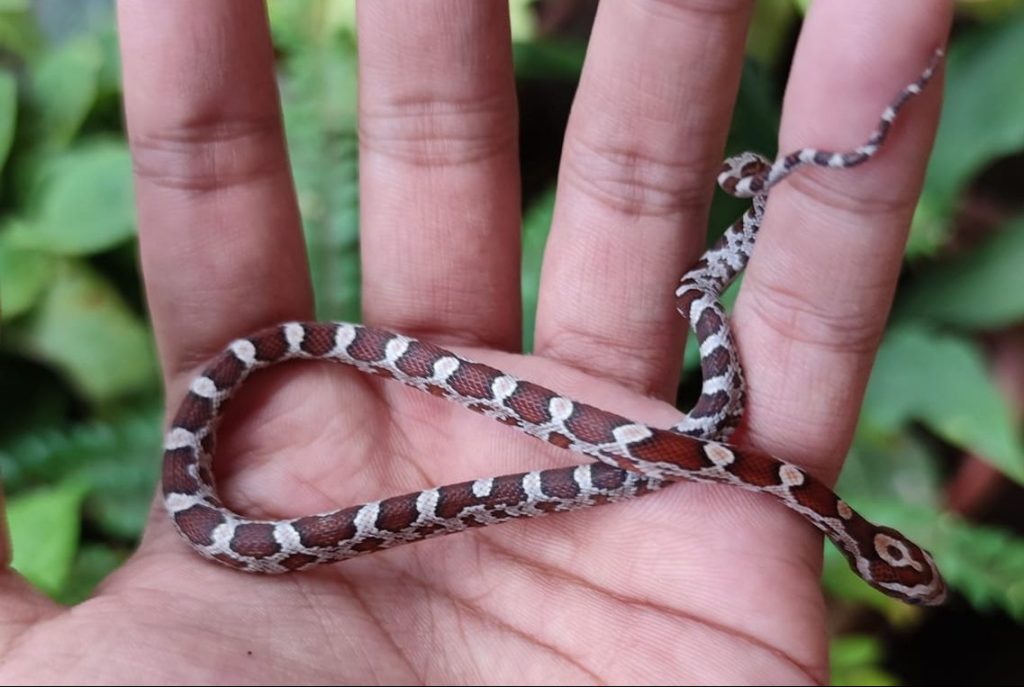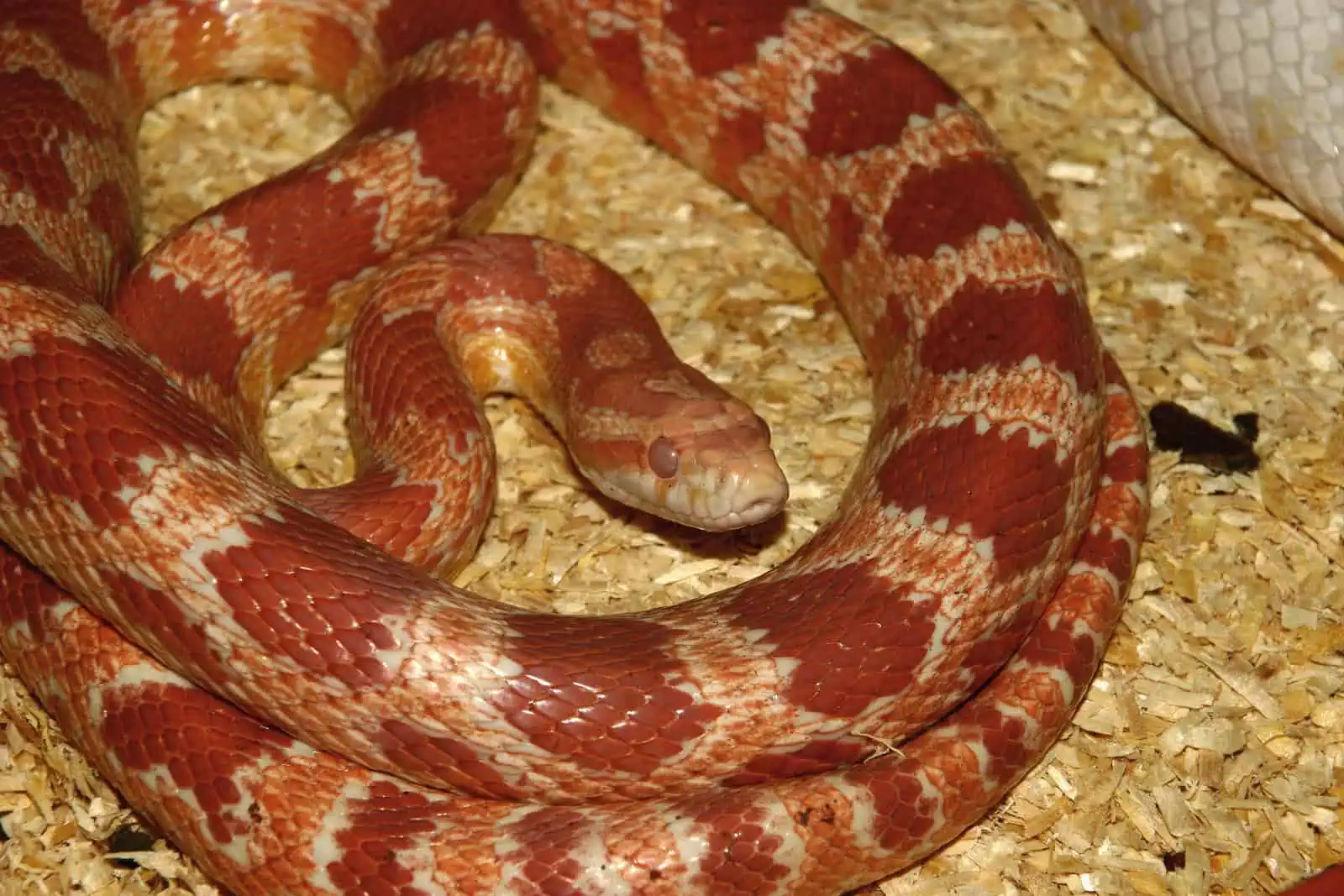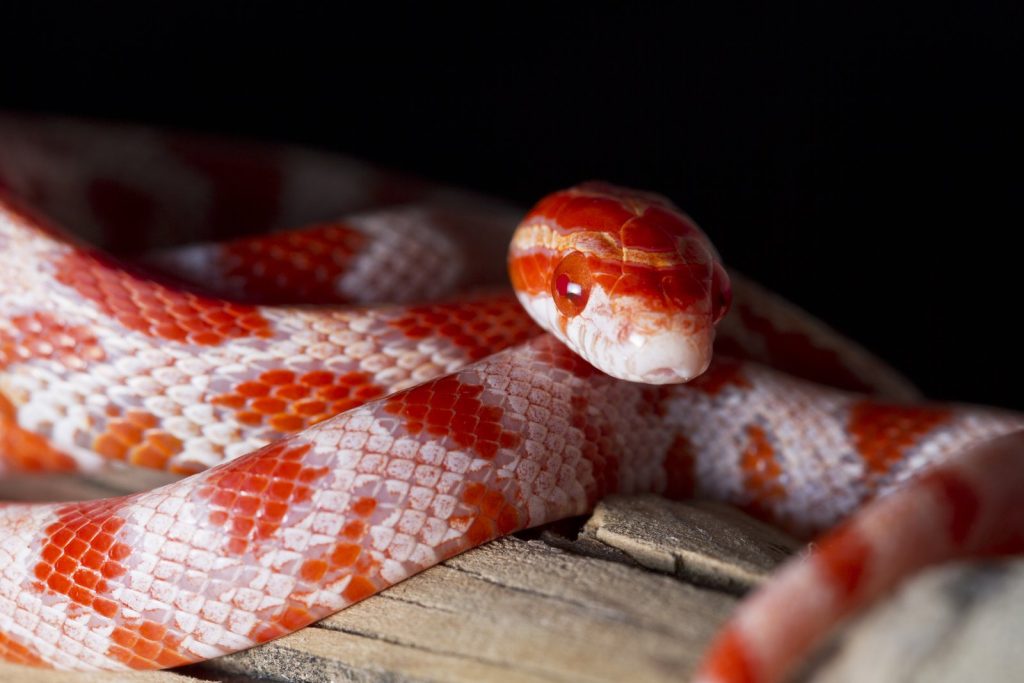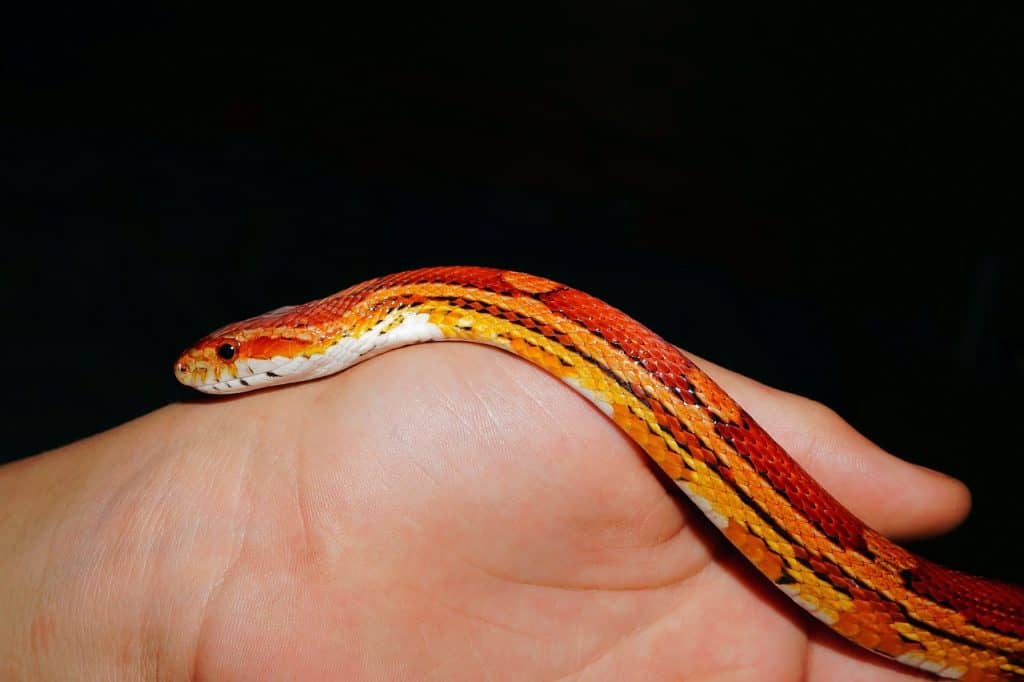Snakes, like individuals, possess unique characteristics. While some snakes exhibit a temperamental nature, others are gentle, docile, and tolerant of human interaction. Certain snakes require more attention, while others are easily cared for. If you’re new to snake ownership or have children at home, selecting a snake you can responsibly care for that poses no danger to your family is important.
You should start with a small, healthy animal that can provide a suitable habitat, proper nutrition, and lifelong care.
Overall, corn snakes offer all these qualities and are one of the most loved pet snakes among snake enthusiasts. They are easy to care for and make excellent pets for children and adults alike. Other reasons involve:
- Docile-nature
- Tolerant to handling
- Available in a wide variety of morphs
- Very hardy
- Not picky-eaters
- Inexpensive food requirements
- Easy to breed
- Extremely curious and active
Let’s explore the fascinating world of these unique snakes and find out why they make such wonderful pets. Additionally, we’ll uncover the following:
- How long can you leave them alone, and what is their average lifespan
- How to bond with them
- Tips before purchasing your slithery buddy

Reasons What Makes Corn Snakes Great Pets
Corn snakes are a very popular choice as pets, ranking second in popularity among snakes. Both beginners and experts adore these captivating reptiles for a multitude of reasons. Below, I’ve mentioned key factors that make corn snakes exceptional companions.
1. Easy To Look After
Corn snakes are not only popular and fascinating animals, but their ease of care makes them an ideal choice for those just starting in the hobby of reptile keeping. Here’s why:
Minimal Space Requirements
You don’t need to worry about providing a huge space for your corn snake: they stay relatively small, usually reaching ~3-6 feet (90-180cm). This makes it easier to find an appropriate setup in your home for them.
Simple Housing Needs
These friendly reptilian companions can flourish in a simple setup. All you need is:
- A secure enclosure with proper ventilation
- Suitable moisture & temperature gradients
- Adequate hiding spots
Their housing needs are uncomplicated, and you can readily find affordable enclosure options at pet stores or online.
Low Maintenance
Corn snakes require minimal maintenance.
Completely change the substrate every few months and regularly clean their enclosure by spot cleaning. As long as the temperature and humidity levels are kept within the appropriate range – corn snakes generally thrive and stay happy and healthy.
2. Docile and Friendly Nature
Corn snakes are known for their friendly and docile nature, rarely exhibiting aggressive behavior towards their owners. They are non-venomous and pose no harm even if they happen to bite.
When they are young, their bites are barely noticeable, often only realized when you see your finger in their mouth – been there! A bite from a fully grown corn snake feels akin to a gentle pinch, possibly drawing a small amount of blood. However, rest assured, it won’t result in excessive bleeding.
3. Can Tolerate Handling
Corn snakes are easy to handle due to their docile nature and low likelihood of biting. They may be quite speedy when they’re young, but they’ll soon become accustomed to being held, and their movement will slow down.
4. Variety of Morphs and Colors
Reptile breeders have worked tirelessly to create captivating pets with various colors and morphs, making them beloved companions. From deep reds to bright oranges, you will surely find a corn snake that suits your style! Over 800 varieties are currently available.
5. Very Hardy
Corn snakes are remarkably resilient and can endure suboptimal conditions better than many other snake species. However, this doesn’t imply that they should be subjected to unsuitable environments. As a novice reptile owner, knowing that your snake won’t be harmed while still figuring out the best habitat setup is reassuring. This way, you can focus on learning and providing the ideal conditions for your snake friend without causing unnecessary distress.
6. Great Eaters
One of the primary concerns for first-time snake owners is the potential refusal of their snake to eat. You may feel overwhelmed when starting as a snake owner, and the last thing you’d want to deal with is them not eating. Corn snakes, however, are renowned for their voracious appetites and rarely pass up a meal. While it is possible to come across a difficult individual, most corn snakes are not picky eaters and make excellent options for first-time owners.
7. Inexpensive Food Requirements
You don’t need to worry about shelling out extra cash for bigger food with this snake breed. These guys are content with their frozen, thawed mouse diet and other small rodents. Plus, starting them on smaller prey is the way to go if you want an easy entry into snake ownership. With these reptiles, it’s all about keeping it small and simple.
8. Easy To Breed
Are you interested in exploring reptile breeding? Corn snakes are a great option. They have been easily bred in captivity for many years, and a wealth of information is available on their genetics and breeding techniques. Breeding corn snakes can be an enjoyable and informative experience for reptile keepers, one you will remember!
9. Extremely Curious and Active
Corn snakes are known for their nocturnal and lively behavior as pets. With their innate curiosity, they enjoy thoroughly exploring their tanks, investigating every nook and cranny. You’ll find great joy and entertainment in observing the multitude of fascinating behaviors and antics your snake engages in. From slithering through intricate tunnels to gracefully climbing branches, there will always be something captivating to witness.
Is a Corn Snake a Good Pet for Kids?
Corn snakes are an ideal choice for children and beginners due to their gentle disposition and minimal biting tendencies. Unlike other snakes, there is no need to worry about them outgrowing their welcome. They are low maintenance, easily handled, and widely accessible.
Can Corn Snakes Be Left Alone?
Corn snakes can be left alone for short periods if you prepare their enclosure properly before you go. They can also go without food for up to 3 months, although this is not recommended. However, there are some things you need to consider before leaving your snake alone.
- Ensure the enclosure’s temperature and humidity are stable and appropriate.
- Provide fresh water in a large shallow dish your corn snake can easily access and soak in. Change the water before you leave, and check it when you return for any signs of contamination or evaporation.
- Feed your snake a few days before you leave, and make sure it has digested its meal completely. You can skip one or two feedings if you are gone for a week or less, but if you are gone longer, you may need to ask someone to feed your snake. Corn snakes usually eat once every 7-10 days, depending on their age and size.
- Clean the enclosure and remove any waste or uneaten food before you leave. This will prevent odors, bacteria, or parasites from harming your snake.
- Provide hiding places and enrichment items for your buddy snake to feel secure and entertained.
What Is the Average Lifespan of a Corn Snake?
Corn snakes typically have a lifespan of around 10-15 years in the wild. However, they can live well beyond 20 years with proper care in captivity. The oldest recorded corn snake in captivity lived an impressive 32 years & 3 months. Corn Snakes kept as pets rather than part of a breeding colony tend to enjoy longer and happier lives. If you’re considering buying or adopting a corn snake, you must be prepared to provide lifelong care and attention.
How Do You Bond With a Pet Corn Snake?
Bonding with a snake differs from bonding with a dog or a cat. Corn snakes do not have emotions or affection for their owners, but they can learn to recognize and tolerate them. Here, I have enlisted some steps you can take to bond with your pet corn snake:
- Give them time to adjust to their new home. When you first get your corn snake, leave it alone for at least a week so it can acclimate to its enclosure and environment. Do not try to handle it during this time, as it may be stressful and defensive. You can rearrange its tank occasionally to let it get used to your presence and smell.
- After the first week, you can start handling your snake for short periods, ~10 to 15 minutes per day. Always approach your corn snake from the side, not from above, and support its body with both hands. Avoid touching its head or tail, which may trigger a defensive reaction. If your snake tries to bite or escape, do not drop or pull it away, as this may hurt or scare it. Instead, gently put it back in its enclosure and try again later.
- To prevent your corn snake from associating your hand with food, feed it in a different container than its enclosure. This way, it will not mistake your hand for prey when you try to handle it.
- Once your corn snake is comfortable with being handled, you can take it out of its enclosure and let it explore a safe and supervised area. This will enrich and stimulate your reptile and allow you to bond.
What To Know Before Buying a Corn Snake?
So, you’re thinking of bringing home a corn snake? But before purchasing, some important factors must be considered to ensure you find the ideal companion.
- Evaluate the overall health of the snake. Pay attention to signs of alertness, clear eyes, and a well-maintained body condition. It’s important to avoid selecting a snake that shows symptoms of illness, such as:
- Mucus discharge,
- Lesions
- Lethargy etc.
- Additionally, consider the temperament of the snake. Look for one that exhibits a calm and docile demeanor. While individual personalities may vary, observe how the snake behaves during handling to ensure it feels comfortable and does not display excessive aggression or stress.
- When acquiring a corn snake, seek out a reputable breeder or rescue organization. These sources can offer valuable insights into the snake’s lineage and health records and provide comprehensive care instructions.
- Finally, consider the potential costs and commitments required to care for it properly. Investing in an appropriate enclosure, reliable heat sources, substrate materials, feeding supplies, and other upkeep elements can require substantial resources.
When considering these factors, you can chose a corn snake that aligns with your preferences and lifestyle. A properly nurtured and harmonious snake will provide you with years of happiness and companionship.
To Sum It Up
Corn snakes make great pets for children and adults alike. Its beautiful natural coloration, small size, and relatively easy care requirements make it an ideal companion for novice snake owners. Corn snakes are the perfect choice whether you’re looking for a pet to bond with. As long as you know how to handle them safely, these beautiful animals can make a great addition to your family!
Do you already have a corn snake as a pet? What advice would you give to those considering it for the first time? Have you noticed any interesting behavior or quirks from your snake that you’d like to share? Let us know in the comments!




